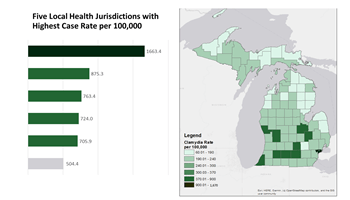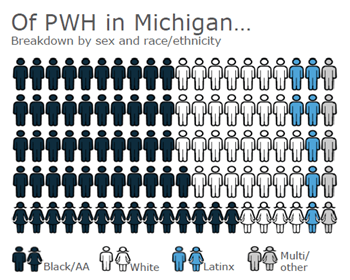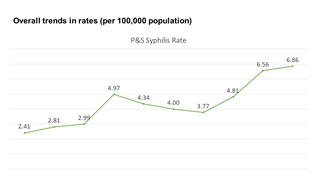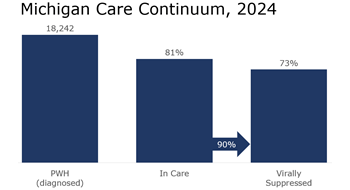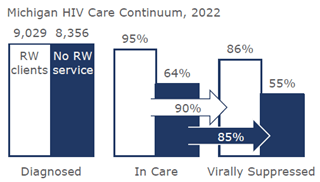The web Browser you are currently using is unsupported, and some features of this site may not work as intended. Please update to a modern browser such as Chrome, Firefox or Edge to experience all features Michigan.gov has to offer.
HIV & STI Data & Statistics
The Michigan Department of Health and Human Services (MDHHS) Bureau of HIV and STI Programs (BHSP) develops reports using surveillance and supplemental data to inform care and prevention efforts and to inform the community.
Request Additional Data
If you would like to request additional aggregate outcome data on people with HIV or affected by STIs in Michigan that is not available below, please use SHOARS to submit a data request.
For detailed instructions on how to register for SHOARS and submit a data request, visit: Michigan.gov/SHOARS. If there are any questions or concerns regarding this process, reach out to MDHHS-SHOARS-SUPPORT@michigan.gov.
Annual Epidemiology Update Webinar
BHSP’s annual epidemiology update webinar took place on March 31, 2025. This webinar provides an overview of HIV and STIs in Michigan, with a focus on emerging trends and program updates.
Recent Reports
- Hispanic and Latino HIV Trends Report (December 2025)
- Data to Care Linkage Outcomes and Identified Barriers Fact Sheet (November 2025)
- Partner Services Fact Sheet, 2024 (November 2025)
- HIV Care Continuum Report, 2024 (data as of October 2025)
- HIV Diagnosis Trends, 2015-2024 (data as of September 2025)
- Maternal and Congenital Syphilis in Michigan Fact Sheet (August 2025)
- HIV Prevalence Report, 2024 (data as of July 2025)
- STI Diagnoses, 2024 (data as of July 2025)
- STI Diagnosis Trends, 2015-2024 (data as of July 2025)
- STI-HIV Coinfections, 2024 (data as of July 2025)
- Shifting Age Priorities - HIV Fact Sheet (July 2025)
- HIV Mortality Report, 2023 (data as of July 2025)
- STI Fact Sheet, 2024 (April 2025)
All Reports
-
Annual STI Diagnoses & HIV Prevalence Report
STI Fact Sheet
STI Fact Sheet, 2024
A brief overview of STI statistics for the 2024 calendar year, released for STI awareness week April 13-19, 2025.
STI Diagnoses
STI Diagnoses, 2024 (data as of July 2025)
This annual report provides the diagnoses during the most recent calendar year for reportable sexually transmitted infections (STIs), including chlamydia, syphilis, and gonorrhea. It includes geographic and demographic breakdowns and highlights disparities in case distribution. All data come from the Michigan Disease Surveillance System.Maternal and Congenital Syphilis in Michigan Fact Sheet
Maternal and Congenital Syphilis in Michigan Fact Sheet (August 2025)
This fact sheet is an overview of maternal and congenital syphilis in Michigan in recent years.
HIV Prevalence Report
HIV Prevalence Report, 2024 (data as of July 2025)
This report focuses on people living with HIV December 31 of the given year. It includes geographic and demographic breakdowns, information regarding HIV Stage 3 (previously known as AIDS), HIV transmission rates, STI coinfections, and historic prevalence estimates. The slides highlight important information found in the tables. The tables include assessments of Michigan as a whole, as well as of the Detroit Metro Area (DMA) and the Detroit Local Health Department (LHD) jurisdiction. -
HIV & STI Diagnosis Trend Reports
STI Diagnosis Trends
STI Diagnosis Trends, 2015-2024 (data as of July 2025)
This report includes 10-year trend analyses for Michigan residents diagnosed with an STI (syphilis, chlamydia, or gonorrhea). Trends are standardized for changing population, and diagnosis rate changes are evaluated for statistical significance using negative binomial regression. Breakdowns are geographic and demographic.HIV Diagnosis Trends
HIV Diagnosis Trends, 2015-2024 (data as of September 2025)
This report includes 10-year trend analyses (negative binomial and Poisson) of people diagnosed with HIV in Michigan. Geographic, demographic, and linkage to care breakdowns are analyzed. It also includes minimal HIV testing information. The slides highlight important information found in the tables. The tables include analyses of Michigan as a whole, the Detroit Metro Area (DMA), and the Detroit Local Health Department (LHD) jurisdiction.HIV Diagnosis Trends - 2020 Special Report (data as of July 2021)
This special report briefly explains why the sharp decline in new HIV diagnoses during 2020 was likely due to a lack of testing rather than a decrease in HIV transmission.
Archived Reports
-
HIV Care Reports
Continuum of Care (CoC)
HIV Care Continuum Report, 2024 (data as of October 2025)
The Continuum of Care was developed by Centers for Disease Control and Prevention (CDC) to assess gaps in care. The report includes geographic and demographic breakdowns for people living with HIV during the entire year (diagnosed before January 1 and still living with HIV December 31). The slides highlight important information found in the tables, which include assessments of Michigan as a whole, the Detroit Metro Area (DMA) and the Detroit Local Health Department (LHD) jurisdiction.Care Continuum and Housing, 2018 (created 2019)
This report compares care disparities among individuals with stable vs temporary or unstable housing. In all of Michigan's Public Health regions, people with temporary of unstable housing experience poorer care outcomes.Ryan White Eligible, Unenrolled Fact Sheet
Ryan White Eligible, Unenrolled Fact Sheet (October 2023)
The vast majority (87%) of people with HIV (PWH) out of care are not enrolled in Ryan White. With such a large care disparity between those who do and do not receive Ryan White services, it is critical to enroll and retain all eligible PWH in Ryan White.Data to Care Reports
Data to Care Linkage Outcomes and Identified Barriers Fact Sheet (November 2025)
This fact sheet provides an overview of the Data to Care initiative in Michigan, summarizes key outcomes from 2022–2024, and outlines common barriers to HIV care and Ryan White service utilization.Link-Up Michigan Outcome Report, 2019 (data as of July 2020)
This report contains information pertaining to the Link-up Michigan program for the city of Detroit and Michigan counties. The report details demographics for not in care residents, outcomes of Link-up investigations, care status for those who accepted care, Link-up investigation contact attempts, and barriers to receiving care. For more information regarding Link-up Michigan, please visit Link-Up MI.
Archived Reports
-
HIV Mortality Report
HIV Mortality Report
HIV Mortality Report, 2023 (data as of July 2025)
The HIV Mortality Report focuses on the number and rates of death among people with HIV in Michigan in the given year. It includes some geographic and demographic breakdowns for comparison in addition to causes of death among various populations. The slide set highlights some of the key information found in the tables.Archived Reports
-
HIV & STI Prevention Reports
-
Coinfections & Co-Diagnoses (including COVID-19)
STI-HIV Coinfections
STI-HIV Coinfections, 2024 (data as of July 2025)
This annual report looks at HIV prevalence among people diagnosed with new syphilis, gonorrhea, or chlamydia infections, as well as the rate of STI diagnoses among all people living with HIV in Michigan. The slides highlight the priority populations who are disproportionately affected by coinfection, while the tables show details by race and sex, age, transmission risk, and local health department. Data comes from the Michigan Disease Surveillance System (MDSS) and from the HIV/AIDS registry (eHARS).
Hepatitis-HIV Coinfections
See Hepatitis B and C Annual Surveillance Report for data on people with hepatitis who are also living with HIV.
TB-HIV Coinfections
TB-HIV Coinfections Fact Sheet (August 2021)
This fact sheet looks at TB-HIV coinfections in Michigan over the past 15 years and highlights the importance of HIV testing among confirmed and probable TB cases.COVID-HIV
COVID-HIV Fact Sheet (data as of July 2021)
This fact sheet looks at diagnoses of COVID-19 among people living with HIV between March 2020 and March 2021 as well as vaccination against COVID-19 among people with HIV in Michigan.
Archived Reports
-
Special Populations
Hispanic and Latino HIV Trends Report
Hispanic and Latino HIV Trends Report (December 2025)
HIV prevalence, the number of people with HIV (PWH), is rising among Hispanic/Latino residents of Michigan. New HIV diagnoses among Hispanic/Latina women in Michigan increased sharply in 2024.Archived Reports
-
Special Analyses
Shifting Age Priorities - HIV
Shifting Age Priorities - HIV Fact Sheet (July 2025)
HIV Mortality in Michigan
HIV Mortality in Michigan, 2014 (data as of 2016)
Archived Reports
- Shifting Age Priorities - HIV Fact Sheet (January 2024)
- National HIV/AIDS Strategy (NHAS)
- An Alternative Methodology for Determining Stage of HIV Infection: Comparing Most Recent CD4 Count or Percent to "Once Stage 3, Always Stage 3" (2013)
- HIV Prevalence in Detroit, Highland Park, and Hamtramck, Adjusted for Population Decline - Summary Report (2013)
-
National HIV Behavioral Surveillance (NHBS)
-
Medical Monitoring Project (MMP)
-
Interactive Vital Records Tables
This MDHHS Vital Records and Health Statistics Section website reports statistics for three types of sexually transmitted infections (STIs): chlamydia, gonorrhea, and syphilis. Syphilis is grouped by all syphilis, or as primary and secondary syphilis. Primary and secondary syphilis reports represent initial stages of syphilis, when transmission is most likely to occur. The website offers 20 years of information for each infection, with data divided into trend tables and yearly tables by gender, age, counties, and health districts.
-
National Data
-
Data Notes
- STI data comes from the Michigan Disease Surveillance System (MDSS). STI cases are dated using onset date, when available, then specimen collection date, if available, and then date referred to the MDSS if both other dates are missing. Cases included in reports are probable and confirmed based on CDC case definitions.
- HIV data comes from enhanced HIV/AIDS Reporting System (eHARS), CAREWare, and Aphirm. In Michigan, mandatory HIV lab reporting began in 2006. Therefore, diagnoses and care measures, in general, are based on laboratory reports.
- eHARS is a browser-based,Center for Disease Control and Prevention (CDC)-developed application that assists health departments with reporting, data management, analysis, and transfer of data to CDC. This system contains basic demographic information (age, race, gender, transmission risk, location) and HIV-related laboratory reports. Advantages: includes all people with HIV who have resided in Michigan; entry/edit rights are restricted to a very small group of staff, ensuring clean and consistent data. Limitations: updates after diagnosis are limited to information included in laboratory reports. eHARS does not capture socio-economic information. Other notes: Prevalence is based on last known address. Major changes to last known address occurred in 2014 and 2020; therefore, reports published since 2020 may not be comparable to previous reports.
- CAREWare is a web-based, electronic health and social support services information system for the Health Resources and Services Administration's (HRSA's) Ryan White HIV/AIDS Program recipients and providers. This system contains basic demographic information (date of birth, race, gender, transmission risk, location), socioeconomic factors (income, housing status, and health insurance provider), and Ryan White services received. Advantages: includes socioeconomic elements, and care service information not dependent on laboratory reports. Limitations: only includes people receiving Ryan White and related services (not all people with HIV); the type of data entry/edits depends on the needs of the agency, which may result in more up-to-date, but less consistent, data, compared to eHARS. Other notes: CAREWare is used to produce federal reports, such as the Ryan White HIV/AIDS Program Services Report(RSR) and the AIDS Drug Assistance Program Data Report (ADR), and supplement eHARS-based reports, such as the Continuum of Care Report.
- Aphirm is a direct-entry database, developed by Luther Consulting, that contains 18-1802-funded HIV testing information and Partner Services data. This system contains demographic information, test results, risk information, and intervention referrals for people tested for HIV in the State of Michigan. Advantages: includes positive and negative test results, and Partner Service networks not available in other systems. Limitations: restricted to PS18-1802-funded tests. Other notes: Much of the data collected in Aphirm is based on self-report.
- Population data comes from the U.S. Census Bureau and the National Center for Health Statistics. These data are used as the denominator in rate calculations so that HIV and STI outcomes can be compared across groups and geographies. Each year, the Census Bureau's Population Estimates Program (PEP) uses current data on births, deaths and migration to calculate population change since the most recent decennial Census and produces a time series of estimates of population. The Census Bureau, however, does not release estimates by single-year of age at the county level due to concerns about the reliability of these estimates, so they are provided to us via the National Center for Health Statistics to meet programmatic needs (e.g., the creation of age groupings that differ from the standard groupings used by the Census Bureau). The Census Bureau's American Community Survey (ACS) provides annual "5-year" estimates, which represent data collected over a period of time. Using the ACS 5-year estimates rather than the 1-year estimates for less populated areas and small population subgroups provides increased statistical reliability. Thus, these estimates are generally used for calculating rates for cities and race, sex, and age subgroups within cities.
- Measuring HIV Linkage to Care (2024)
- Defining Unmet Need and Linkage to Care (2018)
- HIV Transmission Risk Category Definitions (Revised 2023)
